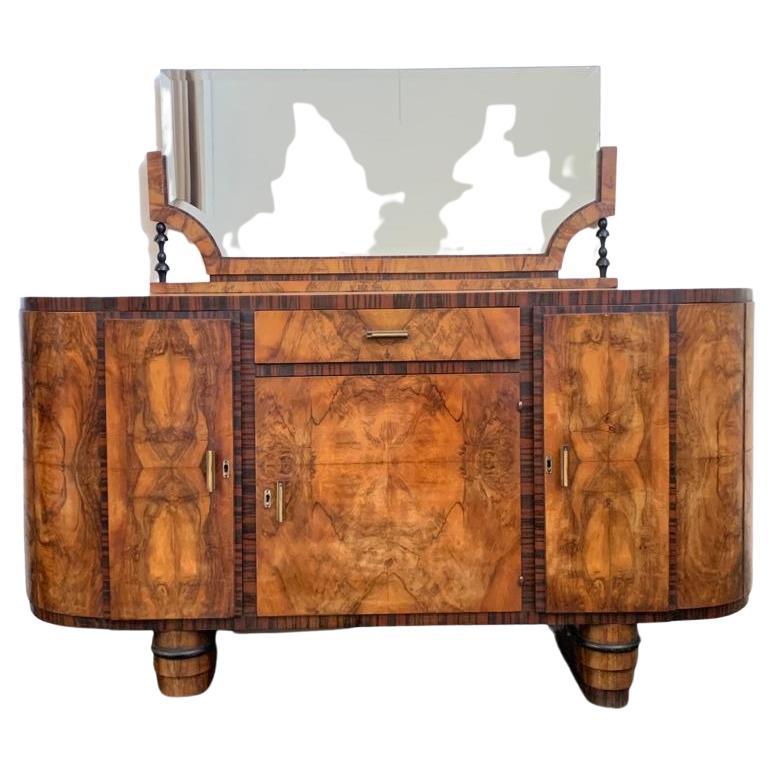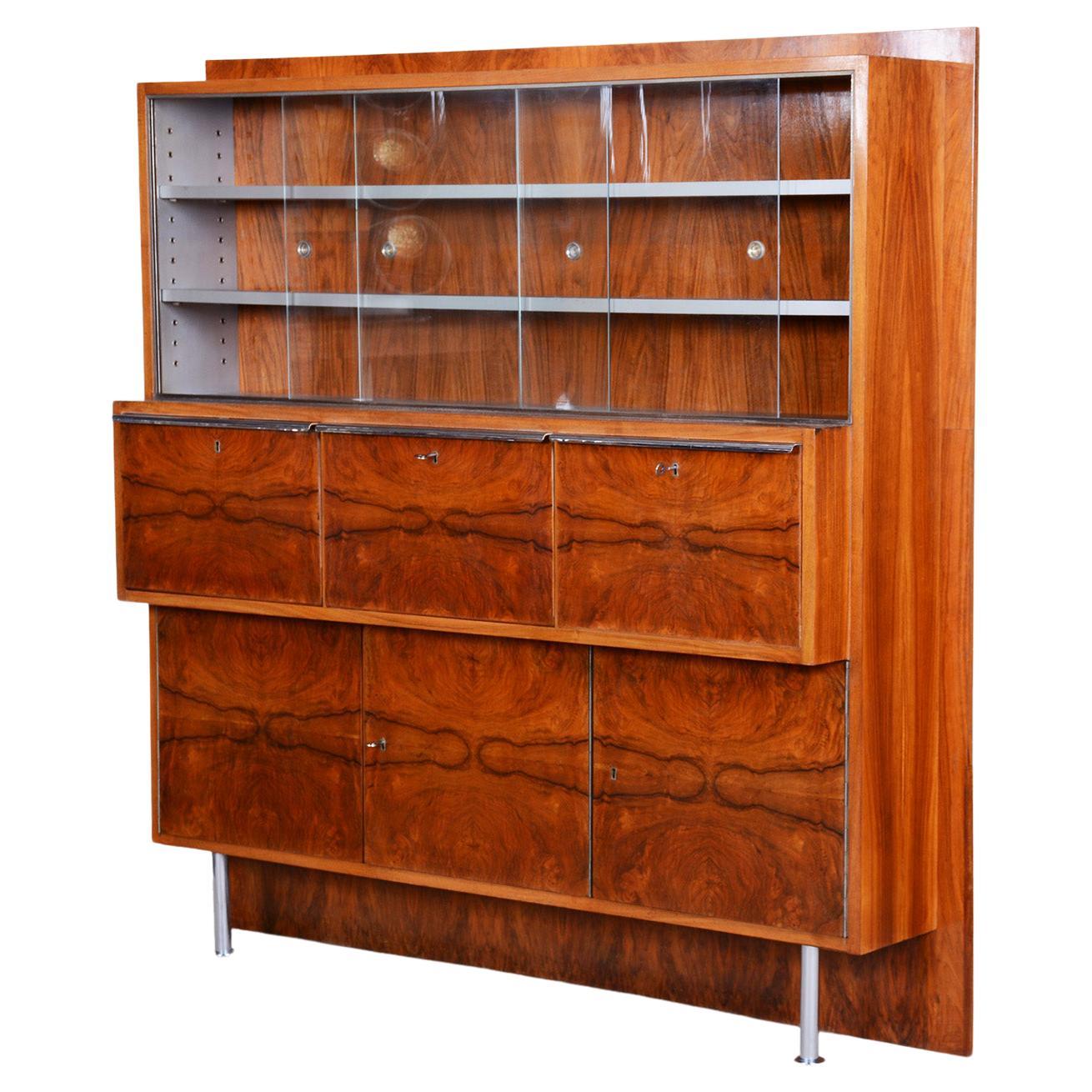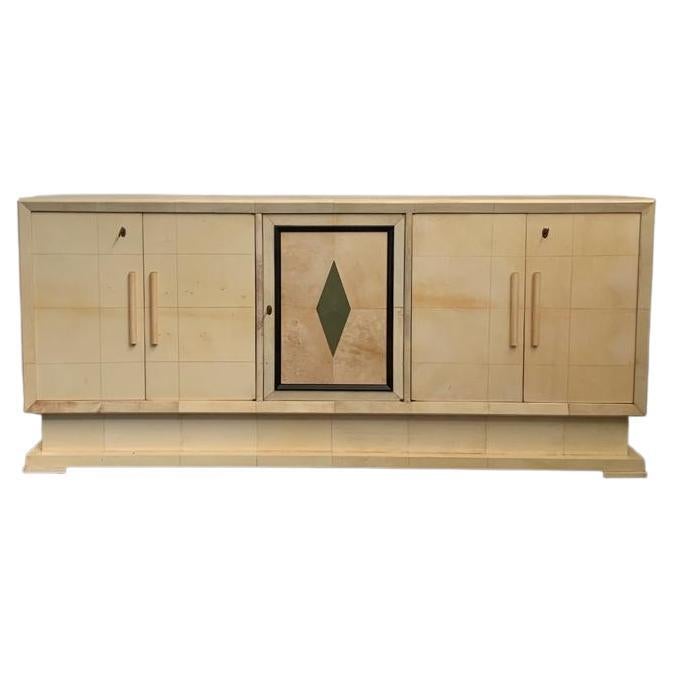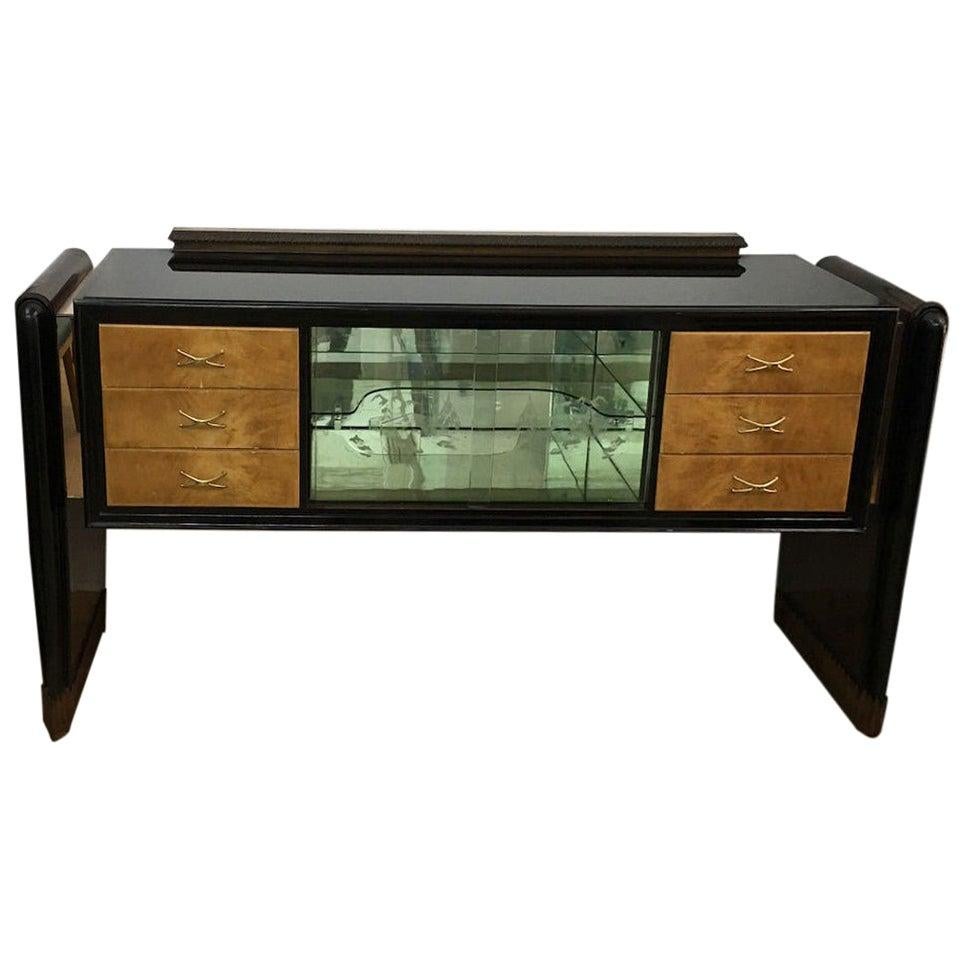Items Similar to Emilio Lancia Large Sideboard in Walnut Wood Italian Manufacture 1930s
Video Loading
Want more images or videos?
Request additional images or videos from the seller
1 of 10
Emilio Lancia Large Sideboard in Walnut Wood Italian Manufacture 1930s
About the Item
A mid-century sideboard with structure in walnut veneer with brass details, the sideboard presents three doors and six inner shelves.
Designed by Emilio Lancia, Italian manufacture from the 1930s.
Emilio Lancia was an Italian architect, and one of the main exponents of the "Novecento" style.
He attended the course in Architecture at the Regio Istituto Tecnico Superiore, where he met Giuseppe de Finetti. At the outbreak of the First World War, he attended the Military Academy in Turin together with Gio Ponti, and during the war, he met Giovanni Muzio and Mino Fiocchi; at the end of the war, he finished his studies and, after a period of practice at the studio of Luca Beltrami, open a studio in Via Sant'Orsola with de Finetti and Muzio.
After some youthful projects, which received considerable appreciation, he began to collaborate continuously with Gio Ponti, realizing some projects in the new style called "Novecento", which was linked to the neoclassical tradition of Lombardy.
These were followed by a progressive evolution towards Rationalism, accepted however only in some of its formal aspects, which led to a definitive break with Ponti. Lancia continued his career with several prestigious projects.
- Creator:Emilio Lancia (Designer)
- Dimensions:Height: 37.41 in (95 cm)Width: 67.33 in (171 cm)Depth: 20.08 in (51 cm)
- Style:Mid-Century Modern (Of the Period)
- Materials and Techniques:
- Place of Origin:
- Period:
- Date of Manufacture:1930s
- Condition:Wear consistent with age and use.
- Seller Location:Montecatini Terme, IT
- Reference Number:1stDibs: LU5304238923182
About the Seller
4.9
Gold Seller
These expertly vetted sellers are highly rated and consistently exceed customer expectations.
1stDibs seller since 2020
102 sales on 1stDibs
Typical response time: <1 hour
- ShippingRetrieving quote...Ships From: Florence, Italy
- Return PolicyA return for this item may be initiated within 7 days of delivery.
More From This SellerView All
- Pier Luigi Colli Large Sideboard in Wood with Drawers Italian Manufacturer 1930sBy Pier Luigi ColliLocated in Montecatini Terme, ITLarge sideboard is entirely realized in oak wood, with four drawers on each side (for a total of eight drawers) and a central storage unit. Designed by Pier Luigi Colli Italian Manufacture from 1938 ca. To reconstruct the story of Pier Luigi Colli, we must take a leap back to the 19th century in Turin, a multifaceted city, in some ways controversial due to its austere and sometimes introverted character, but at the core of a creative drive: and if it is primarily known for its automobile industry, there was a time when Turin was at the height of fame also in the field of furniture and embroidery, thanks to the presence of two entrepreneurial realities. On the one hand there was the MIRAM (Italian Hand-Made Embroidery Manufacture) founded by Pietro Colli in 1850, specializing in gobelin fabrics and bandera embroideries. His daughter Teresa traveled between Italy and Paris to discover the latest trends in fabrics and embroidery, while her younger brother, Pier Luigi Colli (1895-1968), the star of this story, joined the company in 1921. Distinguishing himself for his enterprising personality and willing to continue his father's profession, Pier Luigi was known to his contemporaries as "the artist interior designer", and had no doubts about his future: he moved temporarily to Paris, where he attended L'Ecole des Beaux Arts Décoratives. The other great Turin manufacturer to be mentioned is Martinotti, founded in 1931 by Giuseppe Martinotti and supplier of fine furnishings for the Savoy court, pieces which were characterized by a typically 19th century eclectic style, generally made of exotic woods featuring ivory and tortoiseshell inlays: at that time, Martinotti represented the top of internationality, having even participated in the 1875 Philadelphia exhibition! The two brands' fate merged in 1902, a decisive year for Turin which, hosting the International Exhibition of Modern Decorative Art, became the cradle of the spread of the Liberty style in Italy. In the exhibition, Martinotti exhibited an elegant interior, in which all the textile parts, from the curtains to the seat upholstery, was made by Colli. It was in 1926 that Colli (MIRAM) finally acquired Martinotti, founding a laboratory where, from the savoir faire of the two companies, complete pieces of furniture were created and tailor-made for the customer, from the structure to its upholstery. Meanwhile, Pier Luigi Colli was living in Paris, the ideal place to be in 1925, when the International Exhibition of Modern Decorative and Industrial Arts brought him closer to the work of one of his putative fathers, the great French cabinet maker Jacques-Émile Ruhlmann (Paris, 1879 - 1933). Thanks to Paris, Pier Luigi intertwined contacts with the international beau monde, he started to import Lalique glass from France, while the Colli's clientele expanded and special commissions arrived, such as the creation of the Royal Train of the Savoy family made with Fiat, or the lecture hall in the University of Turin. The success of a brand is also measured by its openness to establishing collaborations with the great designers of its time, in the case of Colli resulting in important creative partnerships: from Gio Ponti, who relied on the brand for his Richard Ginori project in Rome, up to Carlo Mollino, who created with Colli the handrails of the RAI (national TV) auditorium and the windows of the Teatro Regio in Turin; also in Turin, the Morbelli architects collaborated with Colli for the furnishings of the RAI skyscraper, and the architects Gabetti Isola for the interiors of the Stock Exchange in Turin. In the 40s and 50s, having opened a branch in Rome, Colli was at the peak of productivity. The embroidery and textile section continued to be one of its strengths, keeping alive the relations with France and its great masters: among the inspirations were the geometric shapes of the fabrics of Ruhlmann's interiors, or the tactile carpets made by designer Mariod Dorn. And so, another Colli trademark become the "textured carpet...Category
Vintage 1930s Italian Mid-Century Modern Sideboards
MaterialsWood, Oak
- Giovanni Michelucci Torbecchia Sideboard in Walnut Wood by Poltronova 1964By Poltronova, Giovanni MichelucciLocated in Montecatini Terme, ITTorbecchia sideboard is entirely realized in solid veneered walnut wood, with two frontal hinging doors (inner shelves), two drawers, and a storage unit under the openable top part. ...Category
Vintage 1960s Italian Mid-Century Modern Sideboards
MaterialsWalnut, Wood
- Giotto Stoppino Sheraton Sideboard in Black Lacquered Wood by Acerbis 1977By Acerbis, Giotto StoppinoLocated in Montecatini Terme, ITSheraton sideboard presents two sliding doors that slide outward to expose three inner storage units with glass shelves and four drawers on the central part. The sideboard has a str...Category
Vintage 1970s Italian Mid-Century Modern Sideboards
MaterialsLaminate, Wood, Ash
- Gio Ponti Round Coffee Table in Walnut Wood Italian Manufacture 1950sBy Gio PontiLocated in Montecatini Terme, ITRound coffee table realized in walnut wood with metal details, the tabletop presents an elegant circular decorative motif. Attribuited to Gio Ponti, Italian manufacturer from the 1950s Gio Ponti was an icon of the modernist movement: the Italian designer, architect, artist and publisher contributed significantly to the worlds of architecture and design with his extensive work in fine furniture and ceramics, education, office and residential buildings, and everything in between. Giovanni, known as Gio Ponti was born in 1891 in Milan. It was there that he spent his childhood, and in 1921 he began to study architecture at the Politecnico di Milano. From 1923 to 1930 he served as the artistic director of the Richard-Ginori porcelain factory. In 1927, Ponti started his first architectural office, together with Emilio Lancia, and in 1928 he started the magazine Domus, which is still regarded as one of the most influential European magazines for architecture and design. He was also very influential during the period as a curator of the Milan Triennale. After his collaboration with Emilio Lancia had come to an end, upon completion of the Torre Rasini, he began to work as an architect together with the engineers Antonio Fornaroli and Eugenio Soncini...Category
Vintage 1950s Italian Mid-Century Modern Coffee and Cocktail Tables
MaterialsMetal
- Gio Ponti Large Green Vase in Ceramic by Richard Ginori 1930s ItalyBy Gio Ponti, Richard GinoriLocated in Montecatini Terme, ITLarge vase in green ceramic designed by the Italian designer Gio Ponti and manufactured by Richard Ginori between the 1930s and the 1940s. In this piece, the ceramic was modeled with an elegant and raffinate, flared shape that makes it a perfect decorative vase. The manufacturer's brand is stamped under the base. The history of the Ginori Manufactory began in Doccia, just a stone's throw away from Florence, when in 1735 Marquis Carlo Andrea Ginori started a porcelain factory which was destined to become a worldwide icon of style. The eighteenth-century is a key century for the development of porcelain in Europe, in this period the first manufactures are born, fed by new styles and international trends. In stately homes, palaces and courtyards, the precious porcelain of the Doccia Manufactory is synonymous with elegance and refinement. The passage from the nineteenth, the century of reason to that of feeling marks a new chapter in the development of artistic taste and the manufacture of porcelain. Florence becomes the scene of a controversy between the academic supporters of the Beautiful ideal and the naturalists promulgators of the beautiful natural Since 1806 the direction of the Manifattura passed to Leopoldo Carlo Ginori Lisci who initiates a process of profound renewal. In 1986 The Manifattura expanded and the Richard Ginori Ceramic Company is born. The tradition of master craftsmen meets new technologies and the creations are perfected thanks to the use of new patents From 1923 to 1933 the artistic direction of the Manifattura was entrusted to Gio Ponti. The master is responsible for introducing highly innovative elements with sensitivity and respect for the taste for the ancient, and for the oriental culture. In 1925 at the Universal Exposition in Paris, the Manifattura and its artistic director were awarded the assignment to both of a Grand Prix. The Manufactory was renewed by relying on the experience of the greatest Italian designers of the time: Franco Albini, Franca Helg, Antonio Piva, Sergio Asti, Achille Castiglioni, Gabriele Devecchi, Candido Fior...Category
Vintage 1930s Italian Mid-Century Modern Vases
MaterialsCeramic
- Console Table in Black Lacquered Wood and Pink Marble Italian Manufacture 1950sLocated in Montecatini Terme, ITA Mid-Century Modern style console table with a structure in black lacquered wood and a tabletop in pink marble. The console table presents a single drawer on the frontal part. ...Category
Vintage 1950s Italian Mid-Century Modern Console Tables
MaterialsMarble
You May Also Like
- Oval Sideboard with Mirror in Walnut, Burl and Ebony Macassar, Italy, 1930sLocated in Montelabbate, PUSplendid oval sideboard with mirror made of select walnut burl and framed in Macassar ebony with slight reliefs or protrusions on the body of the sidebo...Category
Vintage 1930s Italian Art Deco Sideboards
MaterialsEbony, Walnut, Burl
- Restored Art Deco Sideboard, Made in 1930s Czechia, WalnutLocated in Horomerice, CZFully restored, made out of walnut in 1930s Czechia.Category
Vintage 1930s Czech Art Deco Sideboards
MaterialsWalnut
- Vintage Black Walnut Divider Cabinet in the style of Emilio Lancia, ItalyBy Emilio LanciaLocated in Bresso, LombardyMade in Italy, 1930s. It is made in black walnut and features brass handles. This is a vintage item, therefore it might show slight traces of use, but it has been perfectly restored...Category
Vintage 1930s Italian Mid-Century Modern Cabinets
MaterialsBrass
- Art Deco Italian Parchment Sideboard, 1930sLocated in Montelabbate, PUArt Deco Italian parchment sideboard, 1930s.Category
Vintage 1930s Italian Art Deco Sideboards
MaterialsParchment Paper
- 1930s Amazing Art Deco Wood and Pink Mirror Italian SideboardLocated in Aci Castello, ITItalian Art Deco sideboard made in Como Northern Italy in the 1920s, three kind of wood, mahogany, maple and black painted wood, pink glass mirror in...Category
Mid-20th Century Italian Art Deco Credenzas
MaterialsWood, Mahogany, Maple, Glass
- Mahogany Sideboard, 1930sLocated in Montelabbate, PUSideboard in mahogany ebonized profiles, with niche in mosaic mirror for sculpture, black crystal top, brass handles. Shelves are missing.Category
Vintage 1930s Italian Art Deco Sideboards
MaterialsBrass





